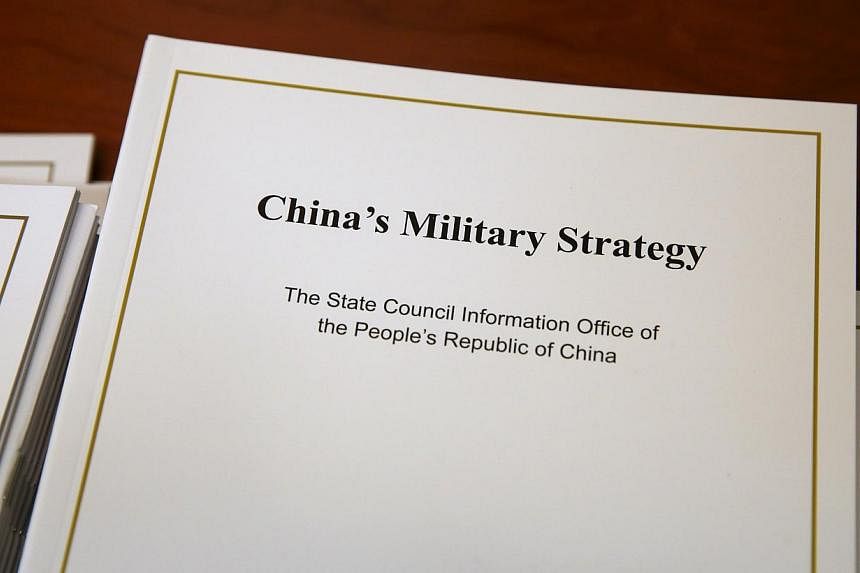China has outlined a greater role for its military in a bid to effectively secure growing interests overseas.
In a White Paper on defence released on Tuesday (May 26), it highlighted the seas as "critical" for the country's stability and development, adding to regional tensions over disputed waters in the South China Sea.
Here's what you should know about the White Paper:
1. Adherence to peaceful development
In the document, China reaffirms its adherence to peaceful development and its "active defence" military strategy. "We will not attack unless we are attacked, but we will surely counterattack if attacked," it states. "China will never seek hegemony or expansion."
2. Increasing security challenges
Noting that the world's economic and strategic centres are shifting to the Asia-Pacific region, it highlights increasing challenges posed by certain countries, citing the growing US military presence in Asia and Japan's major adjustment in its security policies.
The paper notes that "some offshore neighbours take provocative actions and reinforce their military presence on China's reefs and islands that they have illegally occupied", presumably referring to Vietnam and the Philippines which have reportedly carried out land reclamation in the disputed South China Sea.
"It is thus a longstanding task for China to safeguard its maritime rights and interests."
3. Four critical security domains:
The White Paper says the following about four critical security domains it has identified:
a. Seas and oceans: This is important for China's stability and sustainable development. China places great importance on guarding maritime rights and interests, and protecting strategic sea lines of communication and overseas interests.
b. Cyberspace: China is facing "grave security threats" to its cyber infrastructure and has been a victim of hacker attacks. It will expedite the development of a cyber force to ensure network and information security, and participate in international cyber cooperation.
c. Nuclear force: Nuclear force is a strategic cornerstone for safeguarding national sovereignty and security. China will keep its capabilities at a "minimum level" required for maintaining security and will adhere to a self-defensive nuclear strategy.
d. Outer space: The first signs of weaponisation of outer space have appeared. China will secure its space assets to serve economic and social development, while maintaining outer space security.
4. Open seas protection
The White Paper states that the People's Liberation Army (PLA) navy will add the duty of "open seas protection" to "offshore waters defence", while its air force will shift its focus from territorial air defence to both defence and offence.
"With the constant expansion of the maritime battlefield, it is no longer effective for national maritime safety to just concentrate on the defence of coastal waters," Senior PLA Colonel Wang Jin said at the launch of the White Paper.
The document states that the "traditional mentality that land outweighs sea must be abandoned". While it reiterates a long-held stance that China would continue to pursue a security policy that is defensive in nature, the White Paper hits out at foreign countries "busy meddling" in South China Sea affairs, and neighbouring nations that take "provocative" actions on China's reefs and islands.
5. A more confident and assertive military force
Analysts say the White Paper underscores the growing confidence of China's modernising military force. In laying out its military strategy in the paper for the first time, Beijing can claim to be increasing the transparency of the PLA to the outside world, while warning off those deemed to have ill intentions towards the country.
"China now feels that the area it needs to defend has grown - and it is no longer held back by its military's limitations," says Dr Wang Xiangsui from Beihang University.
The military's budget has seen double-digit increases for years, as China seeks to modernise its forces. It added its first aircraft carrier in 2012 and is today the world's second-largest military spender, although it lags far behind the United States.
Now that China's forces are stronger, it is natural for it to increase its capabilities and area covered, says Dr Wang.
The White Paper also shows the Chinese military is more confident and assertive in its stance under President Xi Jinping, according to analyst Ni Le-xiong. While the document has been issued regularly since 1998 - mainly to deflect criticism that the PLA is not transparent - it is only under Mr Xi's leadership that the White Paper has taken a thematic approach and sought to give more details on specific issues.
The last report in 2013 was titled The Diversified Employment Of China's Armed Forces and gave details of military manpower numbers, while this year's report is called China's Military Strategy and purportedly sheds light on the issue for the first time.

